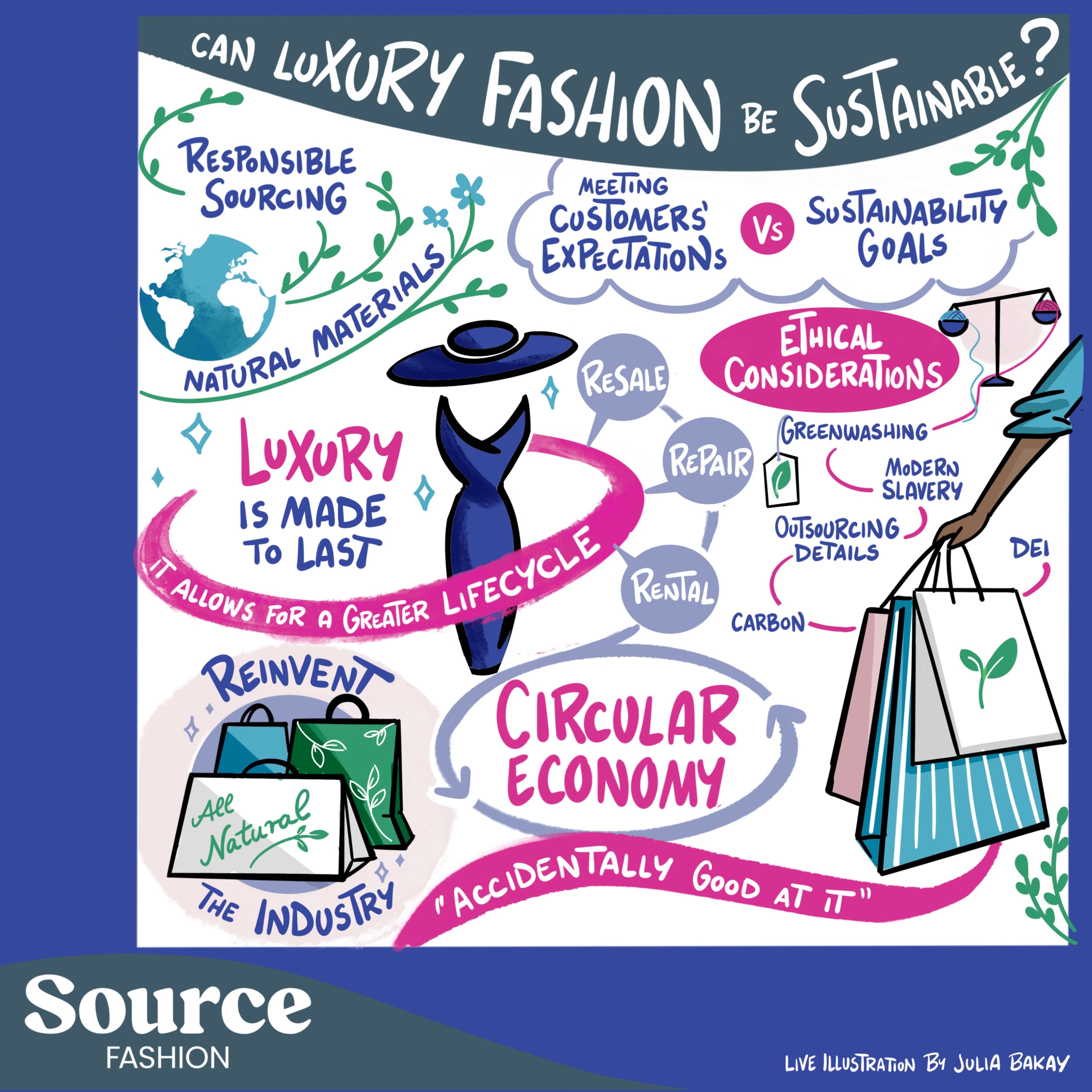Can luxury fashion ever be sustainable?
)
Welcome to Source Illustrated - a blog series built from the energy and ideas of our Source Debates stage at Source Fashion, July 2025. We teamed up with Julia Bakay, who captured the energy and ideas into a powerful infographic. Each week we'll explore the themes from the artwork, uncovering the ideas around some of the industry's most pressing questions.
Want to see them in action? Register here for the next show
Luxury fashion has always carried a paradox. On one hand, it’s about craftsmanship, quality, and pieces designed to stand the test of time. On the other, it’s still part of an industry under pressure for its environmental footprint, complex supply chains, and overconsumption culture. So, can luxury fashion ever truly be sustainable - or is the very idea a contradiction?

Luxury is built to last
Unlike fast fashion, luxury has longevity at its core. A well-cut coat or a leather handbag isn’t designed for a single season, but for decades of wear (in theory). That durability, if embraced fully, is sustainability in action. When garments last longer, they reduce the need for constant replacement, lowering the overall demand for raw materials and energy.
Longevity is the first step towards a greater lifecycle, and luxury has an advantage here: it’s already, accidentally, good at it. But the challenge is shifting consumer behaviour to match.
Owning fewer, better pieces only works if shoppers see luxury as an investment in the long term, rather than another trend to collect. That means education, transparency, and design choices that prioritise timelessness over disposability.
Responsible sourcing and natural materials
Behind every luxury garment is a supply chain, and here’s where the cracks start to show. Responsible sourcing isn’t always guaranteed, even in the high-end market. From cotton to cashmere, the materials matter. Increasingly, consumers are looking for natural, traceable fabrics that balance indulgence with environmental care.
Luxury brands are under pressure to show exactly where their raw materials come from, who’s making their products, and under what conditions. Luxury doesn't always equal ethical and responsible... Just like the rest of the fashion ecosystem, supply chain transparency is becoming more important.
The recent scandal around Lora Piana, where the brand was found to be exploiting its laborers. is starting to shed a light on some systemic issues within the supply chain and shows that sometimes luxury doesn't always equal ethical.
Balancing customer expectations with sustainability goals
There’s a tension at the heart of luxury: the need to meet customer expectations for constant novelty while pursuing sustainability targets. Shoppers still want new collections, limited drops, and the status of exclusivity. But overproduction and endless product cycles undermine sustainability efforts.
Forward-thinking brands are experimenting with new business models: made-to-order, rental, or resale services that keep luxury products in circulation without flooding the market. Meeting customer desires while staying true to climate commitments is the new balancing act.
The rise of circular economy thinking
Circularity offers luxury a roadmap. Resale platforms, repair services, and rental schemes are no longer niche - they’re becoming integral parts of the industry. For luxury, these models feel natural. After all, a Chanel bag or Hermès scarf is designed to be passed down, repaired, and treasured.
When circularity is embraced fully, it changes the narrative. Fashion is no longer about linear consumption—buy, wear, discard—but about constant reinvention. A garment can have multiple owners, multiple lives, and still hold its value. It’s an ecosystem that benefits both consumers and brands, while reducing the industry’s environmental burden.
Ethical considerations
Sustainability isn’t just about carbon or textiles; it’s also about people. Modern slavery, outsourcing practices, and diversity, equity, and inclusion (DEI) are under scrutiny. Luxury brands have historically guarded their supply chains with secrecy, but in the age of accountability, that opacity is no longer tolerated.
Consumers demand assurance that luxury doesn’t come at the cost of exploitation. Ethical sourcing, fair labour, and transparent governance are now central to the definition of what makes fashion sustainable. Without them, even the most eco-friendly materials or circular initiatives risk being dismissed as greenwashing.
Reinventing an industry
Luxury fashion stands at a crossroads. Reinvention isn’t just about sustainability; it’s about redefining value. Consumers increasingly see worth not in endless novelty, but in timeless design, quality, and ethical integrity. For luxury, that could be an opportunity to lead.
If the industry embraces durability, responsible sourcing, circular business models, and transparency, luxury could move from being “accidentally good at sustainability” to being deliberately, unashamedly built around it.
The question is no longer can luxury fashion be sustainable. It’s how fast the industry can adapt - and whether consumers will embrace the shift from constant consumption to conscious investment.
About the debate
See the debates in action at the next show by registering here
This blog was inspired by the Source Fashion debate “Can luxury fashion ever be sustainable?” hosted by Dax Lovegrove, ESG advisor at Planet Positive

